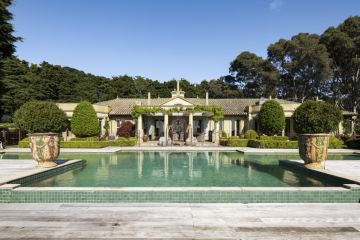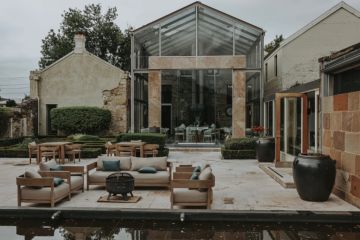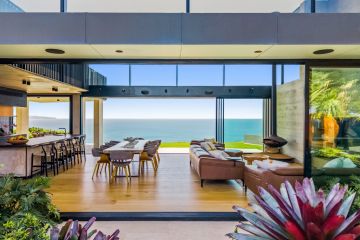The Design Files: Architect John Henry's remarkable 'Research House' in Eltham
Who: Architect John Henry and Deb Ganderton
Where: Eltham, Victoria
What: Architect’s self-designed home
Architect John Henry and his wife Deb Ganderton are the humble owners of the truly remarkable Research House in Eltham. A mind-boggling 1000 cubic metre space, with 6.5-metre-high walls and a jaw-dropping sheer wall of south-facing windows overlooking leafy bushland, this is a home unlike any other.
Designed by Henry, the house was built from scratch starting in 2000. Although grand in scale, this is a home built on a budget. Henry and Ganderton bought their block for $105,000 in 1998, and then spent about $250,000 building the house. The build took two years; they kept running out of money, which held things up a bit.
“We had underestimated the cost of building it, so we had to stop and save some money, but eventually we got there,” Henry says.
The design was his vision, a sort of synthesis of aspects of all his favourite buildings across the world. “What I thought I would do, was go over my 40-year career and pick out all the things I liked about architecture and the buildings from all over the world,” Henry says.
“Featherston House (1967) by Robin Boyd and Paul Rudolph’s office Manhattan (1965) were the most influential factors on my concept, and I added all the other things I liked to those inspirations.”
- Related: How Sascha found her dream home
- Related: A serial renovator finds a ‘forever home’
- Related: Inside a designer’s magical home
Budget constraints forced Henry to work in the simplest and most affordable way; the house was constructed using a factory-made shed that Henry customised.
It comprises five open “rooms”, demarcated by changes in floor level rather than dividing walls. A lot of the interior is exposed, creating a strong connection between the interior spaces and the outdoors. In fact, the house is built right into the hillside incorporating rocks and vegetation into the design.
“Inside, there are all these plants and indoor gardens with rocks; it’s a contrast between the very industrial and the organic,” Henry says.
And then, there’s the museum-like collection of 1960s art, designer furniture and objects. Henry is particularly fond of his op art (optical art) collection, because “it plays havoc with your eyes.” The furniture, though, is his most prized collection. “I love all of it,” he says. “Trying to say which is your favourite is like picking a favourite child. They are all my favourites.”
Henry is the first to admit that the home does have its challenges. “It gets hot in summer and it can get cold in the winter,” he says. During spring, the house is at its best, with light streaming in and an endless parade of native birds beyond the windows. “It’s like a treehouse.”
The Design Files guide to open-plan living
A few considerations to ensure an open-plan home still feels cosy and comfortable:
- Without walls to delineate between living, eating and sleeping, it’s worth zoning areas with placement of furniture, shelves and rugs, to avoid a space feeling too expansive and overwhelming.
- Use overhead or task lighting to create zones in an open space.
- Open-plan living can be inefficient when it comes to heating and cooling. Consider internal screens, sliding doors or curtains to section off zones and retain heat in winter.
- Even in an open-plan space, there’s always something you’d probably prefer isn’t out on display. In the kitchen, consider concealed cabinetry to hide clutter.
We recommend
We thought you might like
States
Capital Cities
Capital Cities - Rentals
Popular Areas
Allhomes
More







